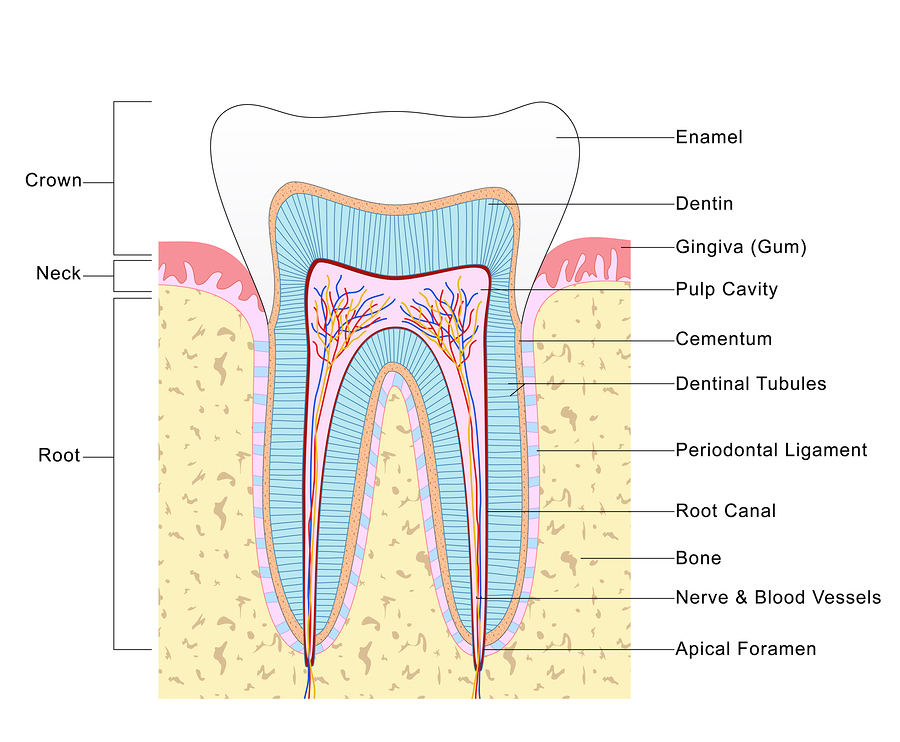All About Root Canals
Have you ever heard the expression, “I’d rather have a root canal than…(insert undesirable thing here)?” Because of the commonly accepted idea that root canal treatment is one of the most painful dental procedures, many people are apprehensive when their dentist or endodontist recommends one. Know that the purpose of a root canal treatment is to save a tooth and relieve pain, not cause it!
Though the procedure is commonly called “a root canal,” you may be surprised to learn that this name actually refers to the part of the tooth the procedure focuses on, rather than the procedure itself. As you can see in the diagram below, the root refers to the area within the dental cavity that surrounds the nerves and blood vessels and holds the tooth’s pulp.

Labelled diagram of the structure of tooth.
Modern dental technology has made the actual root canal procedure fairly painless. So if your dentist recommends a root canal to relieve an infection or abscess, don’t worry. Read on for a better understanding of what you need to expect.
Why Might I Need a Root Canal?
Since root canal treatment clears out infected or inflamed pulp in the tooth, the reason for needing the procedure comes down to the reason for infection or root damage. Gum disease, a chipped or cracked tooth, repeated dental procedures and advanced tooth decay can all contribute to the need for root canal treatment. If the root of the tooth is infected, the entire tooth is at risk.
What Happens During Root Canal Treatment?
In order to save an infected tooth, the dentist numbs the gums and mouth with a local anesthetic. If the patient is particularly anxious or sensitive to pain, the doctor may also use nitrous oxide. Once the mouth is numb, the dentist will begin the procedure.
- The dentist enters the tooth through the crown with the dental handpiece.
- Once access to the root canal space is established, the doctor cleans the infection out of the tooth, irrigates the canal, and reshapes the space to prepare for the permanent filling.
- Using a rubber-like material called gutta-percha, the dentist fills the root canal in order to replace the diseased pulp.
- A temporary filling is placed in the access space.
- In most cases, the crown (or cap) is placed at a separate visit so that the tooth has time to heal. The crown looks much like a natural tooth and protects the newly restored tooth.
Take a look at this illustration to get a better idea of the process.

What Should I Expect During the Healing Process?
Since most teeth that require a root canal were already causing pain, many people find that temporary discomfort during root canal recovery is very manageable. Basic over-the-counter anti-inflammatory medications are usually sufficient for easing pain. Some people also experience “ghost pain” after a root canal, despite the nerves being removed during the treatment, but this typically goes away within a week or two. Important: Avoid hard, sticky or crunchy foods until the final crown is placed. This will help you avoid feeling excess discomfort and damaging the temporary filling.
Do I Need Root Canal Treatment?
If you are experiencing tooth pain or have recently experienced some kind of tooth trauma, schedule an appointment with a dentist. It’s possible that root canal treatment may be the answer to heal your pain. If you are in the Hampton Roads area, call Vacendak Dentistry at 757-609-3510. We are conveniently located near both Chesapeake and Virginia Beach in the Greenbrier/Kempsville corridor. You can also request an appointment online.
